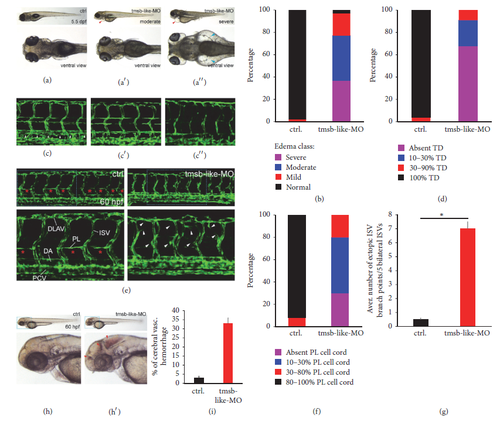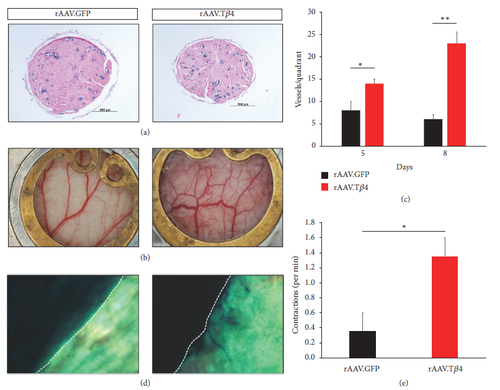- Title
-
Thymosin β4 Improves Differentiation and Vascularization of EHTs.
- Authors
- Ziegler, T., Hinkel, R., Stöhr, A., Eschenhagen, T., Laugwitz, K.L., le Noble, F., David, R., Hansen, A., Kupatt, C.
- Source
- Full text @ Stem Cells Int.
|
Identification of a Thymosin 4 ortholog in zebrafish. (a) Amino acid sequence alignment of zebrafish beta Thymosin and beta Thymosin-like andmouse and humanThymosin 4. The yellow box indicates the consensus actin bindingmotif, indicating a closer degree of homology of zebrafish betaThymosin-like to themammalianThymosins than betaThymosin. (b)The comparison of the genomic localization of beta Thymosin and beta Thymosin-like in zebrafish, in relation to the murine and human localization, shows a closer proximity of beta Thymosin-like than beta Thymosin to the mammalian Thymosin 4. (c) Vector used to integrate pEGFP-N1-tmsb-like in zebrafish with indicated binding site of tmsb-like morpholinos (tmsb-like-MO) used to knockdown tmsb-like in zebrafish. (d) Treatment of pEGFP-N1- tmsb-like expressing zebrafish embryos with tmsb-like-MO demonstrates high knockdown efficiency. |
|
Effect of morpholino mediated tmsb-like knockdown in zebrafish. (a) Edema formation in zebrafish treated with tmsb-like-MO. Knockdown animals show moderate (a′) to severe (a′′) edema formation compared to control ((a), arrowhead), which was quantified in (b) (n=123 for control-MO and 114 for tmsb-like-MO). (c) Thoracic duct (TD) formation was blunted to a moderate (c′) to sever (c′′) degree in tmsb-like-MO animals compared to proper TD formation in control animals 5.5 days postfertilization (dpf, (c), arrowhead). Results were quantified in (d) (n = 112 for control-MO and 103 for tmsb-like-MO). (e) Knockdown of tmsb-like leads to the aberrant formation of intersegmental vessels (ISV) displaying an ineffective hypersprouting phenotype (arrowheads) and a perturbation of parachordal lymphatic vessel generation by parachordal lymphangioblasts (PL) 60 hpf. (PCV: posterior cardinal vein, DA: dorsal aorta, and DLAV: dorsal longitudinal anastomotic vessel). (f) Presence of parachordal lymphangioblasts in 10 successive somites (n = 109 for control-MO and 118 for tmsb-like-MO) and (g) average number of ectopic ISV branch points in 5 bilateral ISV (n=55 per group, *p < 0.05) demonstrate excessive branching and ineffective parachordal vessel formation in animals lacking tmsb-like. (h and i) tmsb-like-MO treated animals displayed a high rate of cerebral vascular hemorrhage compared to control-treated animals 60 hours postfertilization (n = 225 for control-MO and 204 for tmsb-like-MO, *p < 0.05). |
|
Increased vascularization and contractility in engineered heart tissue underThymosin 4 treatment. ( a) Cross sections of EHTs fromreporter mice expressing LacZ in endothelial cells (Cdh5-CreERT2 × Rosa26-LacZ) reveal an increase in capillary density if treated with T4. (b and c) AAV-mediated transfection with T4 (rAAV.T4, versus rAAV.GFP as control) of EHTs implanted into skinfold chambers leads to an increase of graft-vascularization, both 5 and 8 days after implantation ( = 4 per group, ∗ < 0.05; ∗∗ < 0.0008). (d) Images of whole skinfold chambers containing EHTs generated fromLacZ reporter mice show little sprouting of graft resident endothelial cells into host tissue, while rAAV.T4 treatment drastically induces angiogenic sprouting into the host tissue of skinfold chambers (dotted lines indicate the graft/host border). (e) Treatment with rAAV.T4 leads to an increase of spontaneous contractions in implanted EHTs compared to rAAV.GFP control ( = 4 per group, ∗ < 0.05). |



